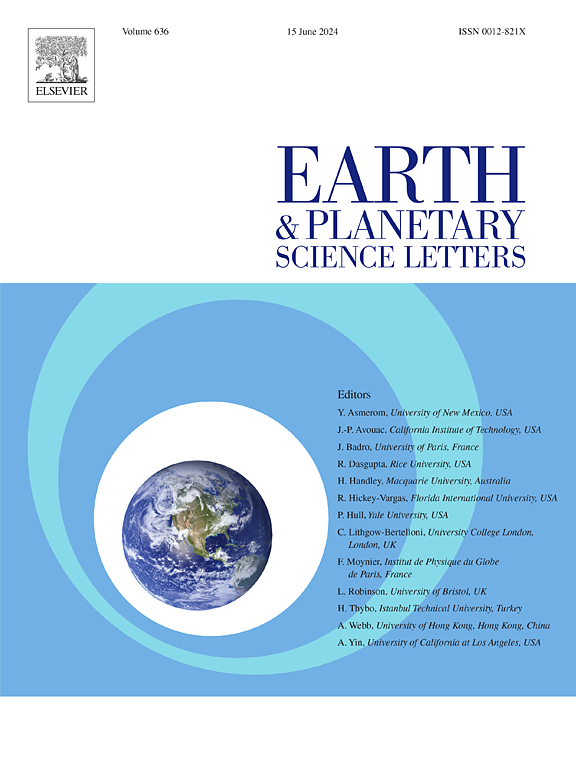New pressure-temperature-time constraints on initial India-Asia collision from eastern Himalayan syntaxis eclogite-facies metamorphic rocks
IF 4.8
1区 地球科学
Q1 GEOCHEMISTRY & GEOPHYSICS
引用次数: 0
Abstract
Eclogite-facies rocks exposed within the Himalayan Range can be used to constrain the timing and characteristics of the India–Asia collision, which remain strongly debated. Many collision-related high- and ultrahigh-pressure lithologies are exposed around the western Himalaya; however, the rarity of similar units in the eastern Himalaya limits our understanding of the along-strike geodynamic evolution of India–Asia collision and the characteristics of the subducted India plate. Here, we document collision-related, low-temperature eclogite-facies metapelites from the easternmost Indus-Yarlung suture zone, which retain vital records of the timing of the initial India–Asia collision in this region. Petrology and phase diagram modeling indicate that the metapelite experienced cold subduction along a low thermal gradient (∼12 °C/km), reaching peak low-temperature eclogite-facies conditions (ca. 1.5 GPa and 590 °C), and was retrogressed to amphibolite-facies conditions during exhumation. Zircon and monazite U–Th–Pb chronology reveals new eclogite-facies ages of ca. 47 Ma, constraining collision of the Indian and Asian continents in the eastern Himalayan syntaxis at ca. 50 Ma, which is consistent with the timing in the western Himalaya and east-central Himalaya. This demonstrates that the initial India–Asia collision occurred quasi-synchronously along orogenic strike, although the maximum depth of subduction of continental material differed. Moreover, the subduction dynamics of continental crust within the collisional orogen exhibit pronounced lateral heterogeneity. These findings further demonstrate a significant change in slab dip angle, convergence velocity, and/or lithospheric strength along strike during closure of the Neo-Tethys Ocean, which must be considered in future geodynamic simulations of the evolution of the orogen.
东喜马拉雅合结榴辉岩相变质岩对印度-亚洲初始碰撞的新压力-温度-时间约束
暴露在喜马拉雅山脉的榴辉岩相岩石可以用来限制印度-亚洲碰撞的时间和特征,这仍然存在激烈的争论。西喜马拉雅地区暴露出许多与碰撞有关的高压和超高压岩性;然而,东喜马拉雅地区类似单元的罕见限制了我们对印度-亚洲碰撞的沿走向地球动力学演化和印度板块俯冲特征的认识。在这里,我们记录了来自最东端印度河-雅鲁藏布带的与碰撞有关的低温榴辉岩相变质岩,这些变质岩保留了该地区最初的印度-亚洲碰撞时间的重要记录。岩石学和相图模拟表明,该变长岩经历了低热梯度(~ 12°C/km)冷俯冲,达到低温榴辉岩相峰值(约1.5 GPa, 590°C),并在挖掘过程中退行至角闪岩相。锆石和独一石U-Th-Pb年代学显示新的榴辉岩相年龄约为47 Ma,限制了喜马拉雅东部构造合带中印度大陆和亚洲大陆在50 Ma左右的碰撞,这与喜马拉雅西部和喜马拉雅中东部的时间一致。这表明,尽管大陆物质的最大俯冲深度不同,但最初的印度-亚洲碰撞是沿造山带走向发生的准同步碰撞。此外,碰撞造山带内大陆地壳俯冲动力学表现出明显的横向非均质性。这些发现进一步表明,在新特提斯洋闭合期间,板块倾角、辐合速度和/或岩石圈强度沿走向发生了显著变化,这必须在未来造山带演化的地球动力学模拟中加以考虑。
本文章由计算机程序翻译,如有差异,请以英文原文为准。
求助全文
约1分钟内获得全文
求助全文
来源期刊

Earth and Planetary Science Letters
地学-地球化学与地球物理
CiteScore
10.30
自引率
5.70%
发文量
475
审稿时长
2.8 months
期刊介绍:
Earth and Planetary Science Letters (EPSL) is a leading journal for researchers across the entire Earth and planetary sciences community. It publishes concise, exciting, high-impact articles ("Letters") of broad interest. Its focus is on physical and chemical processes, the evolution and general properties of the Earth and planets - from their deep interiors to their atmospheres. EPSL also includes a Frontiers section, featuring invited high-profile synthesis articles by leading experts on timely topics to bring cutting-edge research to the wider community.
 求助内容:
求助内容: 应助结果提醒方式:
应助结果提醒方式:


